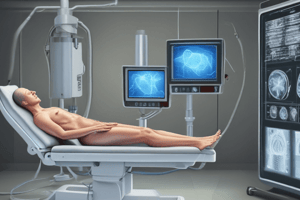Podcast
Questions and Answers
What function does the foramen magnum serve in the skull?
What function does the foramen magnum serve in the skull?
- It allows blood to flow to the brain.
- It protects the brain from physical trauma.
- It describes inflammation in the skull area.
- It is a large hole for spinal cord attachment. (correct)
What does the suffix '-itis' signify in medical terminology?
What does the suffix '-itis' signify in medical terminology?
- An inflammation. (correct)
- An infection-related disease.
- A type of surgery.
- A swelling due to injury.
In which circumstance does negative-feedback mechanism increase heart rate?
In which circumstance does negative-feedback mechanism increase heart rate?
- When blood pressure is excessively high.
- Following moderate blood loss. (correct)
- During a heart attack.
- After severe blood loss.
What typically happens if blood pressure drops too low?
What typically happens if blood pressure drops too low?
Why is it beneficial to learn medical prefixes, roots, and suffixes?
Why is it beneficial to learn medical prefixes, roots, and suffixes?
What best defines responsiveness in organisms?
What best defines responsiveness in organisms?
Which of the following describes the skeletal system?
Which of the following describes the skeletal system?
Which organ systems are involved in maintaining the internal environment of an organism?
Which organ systems are involved in maintaining the internal environment of an organism?
At what level of organization do similar cells combined with surrounding materials form tissues?
At what level of organization do similar cells combined with surrounding materials form tissues?
What action might be included in an organism's response to environmental changes?
What action might be included in an organism's response to environmental changes?
Which of these systems is primarily responsible for the exchange of gases?
Which of these systems is primarily responsible for the exchange of gases?
What process allows the human body to maintain balance among its parts?
What process allows the human body to maintain balance among its parts?
What is the primary function of the integumentary system?
What is the primary function of the integumentary system?
What effect does eating an energy bar have on Renzo's blood sugar levels?
What effect does eating an energy bar have on Renzo's blood sugar levels?
What would happen if Renzo makes a slight movement?
What would happen if Renzo makes a slight movement?
Which organ system is involved in transporting nutrients and waste throughout the body?
Which organ system is involved in transporting nutrients and waste throughout the body?
What is an example of a potential issue Renzo might face related to balance?
What is an example of a potential issue Renzo might face related to balance?
Which of the following describes an important aspect of homeostasis in the human body?
Which of the following describes an important aspect of homeostasis in the human body?
How does Renzo's body respond to the rise in blood sugar after eating?
How does Renzo's body respond to the rise in blood sugar after eating?
What role does digestion play in relation to blood sugar levels?
What role does digestion play in relation to blood sugar levels?
What could a dancer like Renzo experience if his balance is impacted by a disorder?
What could a dancer like Renzo experience if his balance is impacted by a disorder?
What is a primary limitation of radiographs?
What is a primary limitation of radiographs?
What technology serves as the basis for ultrasound imaging?
What technology serves as the basis for ultrasound imaging?
What do ultrasound scanners emit to visualize internal organs?
What do ultrasound scanners emit to visualize internal organs?
How is the information from the reflected sound waves in ultrasound processed?
How is the information from the reflected sound waves in ultrasound processed?
What is produced on a monitor after analyzing ultrasound sound waves?
What is produced on a monitor after analyzing ultrasound sound waves?
What has enhanced ultrasound technology in recent years?
What has enhanced ultrasound technology in recent years?
In which decade was ultrasound first developed?
In which decade was ultrasound first developed?
What is one of the major uses of radiographs?
What is one of the major uses of radiographs?
What does the term 'medial' describe in anatomical terminology?
What does the term 'medial' describe in anatomical terminology?
Which segment of the upper limb is described as extending from the shoulder to the elbow?
Which segment of the upper limb is described as extending from the shoulder to the elbow?
In anatomical position, which direction do the palms face?
In anatomical position, which direction do the palms face?
What are the two directional terms that indicate 'away from the head'?
What are the two directional terms that indicate 'away from the head'?
Which of the following terms describes a position toward the surface of the body?
Which of the following terms describes a position toward the surface of the body?
How many quadrants are formed by the imaginary lines intersecting at the navel in the abdomen?
How many quadrants are formed by the imaginary lines intersecting at the navel in the abdomen?
Which part of the lower limb extends from the hip to the knee?
Which part of the lower limb extends from the hip to the knee?
What is the proper name for the section of the upper limb extending from the elbow to the wrist?
What is the proper name for the section of the upper limb extending from the elbow to the wrist?
Study Notes
Radiographs and Limitations
- Radiographs provide two-dimensional (2-D) images, commonly used to visualize fractures or dental issues.
- Major limitation: the inability to show three-dimensional perspectives of the body.
Ultrasound Technology
- Developed in the early 1950s from WWII sonar technology.
- Utilizes high-frequency sound waves emitted from a transmitter-receiver placed on the skin.
- Sound waves bounce off internal organs, returning to the receiver and analyzed by computers to create sonogram images.
- Recent advancements allow for real-time visualization of organ movement.
Homeostasis in the Human Body
- Homeostasis maintains balance within the body's systems; adjustments occur in response to internal and external changes.
- A dancer, like Renzo, illustrates balance but must adjust his position following movements.
- Blood sugar plays a role in homeostasis; consumption of food affects blood sugar levels.
Organ Systems Overview
- Eleven major organ systems: integumentary, skeletal, muscular, nervous, endocrine, cardiovascular, lymphatic, respiratory, digestive, urinary, and reproductive.
- Each system plays a specific role in maintaining the body’s internal environment and overall function.
Levels of Organization
- Chemical level: Atoms combine to create molecules.
- Cell level: Molecules form organelles (e.g., nucleus, mitochondria), creating cells.
- Tissue level: Similar cells and surrounding material form tissues.
- Organ level: Different tissues work together to form organs, with structure and function interrelated.
Feedback Mechanisms in Homeostasis
- Positive feedback occurs when a deviation from a set point (e.g., low blood pressure) leads to a greater deviation, potentially causing severe conditions.
- Negative feedback works to restore balance (e.g., increasing heart rate after blood loss).
Anatomical Terminology
- Medial: towards the midline; Lateral: away from the midline.
- Superficial: close to the body surface; Deep: toward the interior.
- Body regions identified: abdomen subdivided into quadrants (right-upper, left-upper, right-lower, left-lower).
Importance of Terminology
- Prefixes and suffixes expand medical terminology meaning (e.g., -itis indicates inflammation).
- Learning terminology aids clear communication in professional settings.
Studying That Suits You
Use AI to generate personalized quizzes and flashcards to suit your learning preferences.
Related Documents
Description
This quiz covers the basic concepts of radiographs and their limitations, the use of ultrasound technology in medical imaging, and the importance of homeostasis in maintaining balance within the human body. It explores how different organ systems function and interact. Test your knowledge on these crucial topics in human biology!




